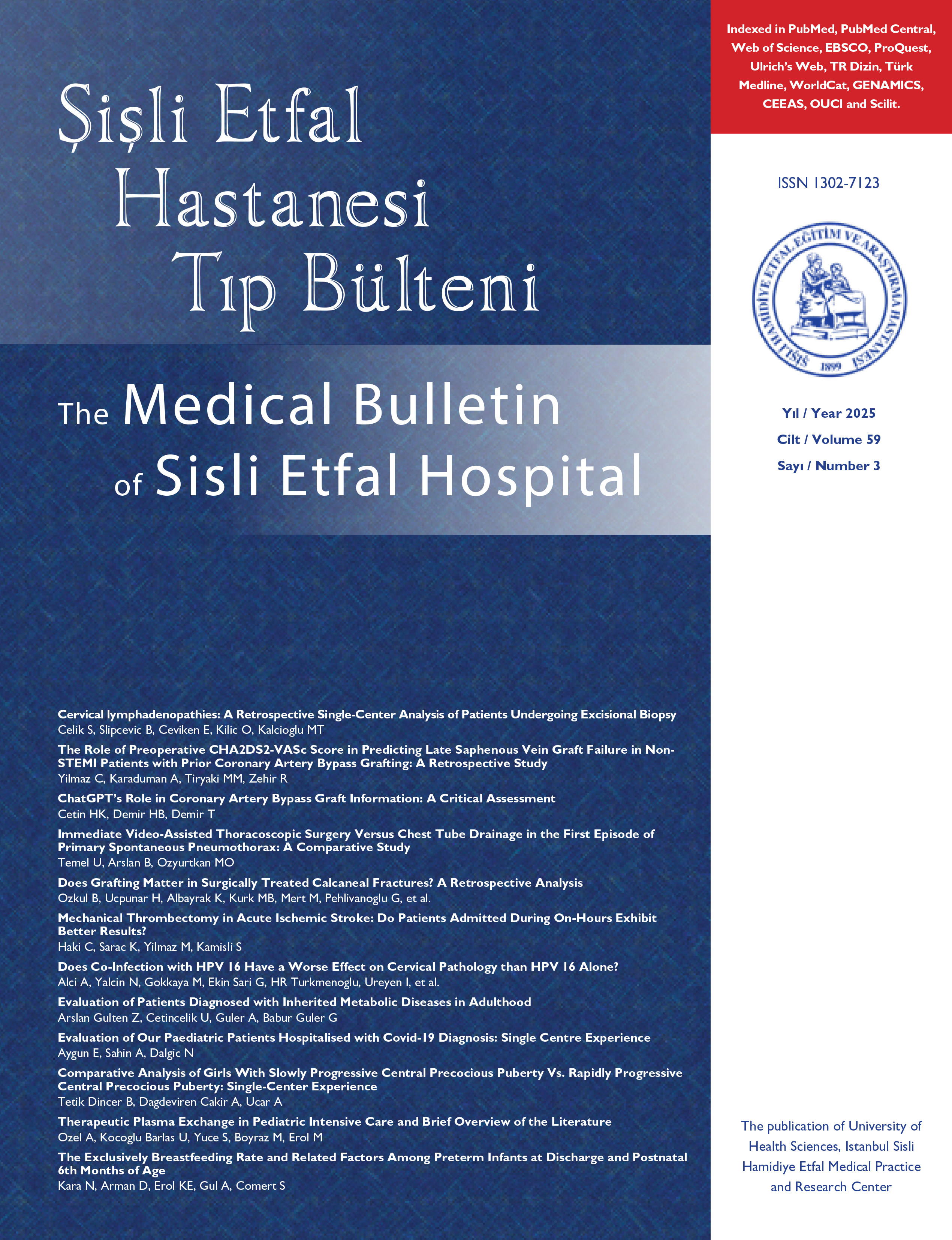
aEEG Assessment for Short-Term Outcome Prognosis Prediction in Hypoxic Ischemic Encephalopathy: An 11-Year Experience
Muhittin Celik1, Ali Bulbul2, Osman Akdeniz31Department of Pediatrics/Neonatology, Diyarbakir Children's Diseases Hospital, Diyarbakir, Türkiye; Department of Pediatrics/Neonatology, Private Medical Point Hospital, Gaziantep, Türkiye2Department of Neonatology, University of Health Sciences Türkiye, Sisli Hamidiye Etfal Training and Research Hospital, Istanbul, Türkiye
3Department of Pediatrics/Cardiology, Diyarbakir Children's Diseases Hospital, Diyarbakir, Türkiye
Objective: Hypoxic-ischemic encephalopathy (HIE) continues to be a predominant cause of morbidity and mortality in neonates. Therapeutic hypothermia (TH) is the only method with proven neuroprotective effects, and the aim of this study was to evaluate the short-term results of patients treated with TH.
Methods: Demographic, clinical characteristics, laboratory and aEEG results of patients who received TH treatment with a diagnosis of Stage II or Stage III HIE according to modified Sarnat staging in the Neonatal Intensive Care Unit were analyzed retrospectively.
Results: A total of 101 patients were included in the study. The mean gestational age of the patients was 38.8±1.5 weeks, the mean birth weight was 3215±499.5 g, and 40.6% were female. According to the modified Sarnat staging, 50.5% of the patients were evaluated as Stage II, and the others as Stage III HIE. The most common peripartum risk factors were meconium delivery (25.7%) and prolonged or difficult labor (20.7%). Mortality rates in patients with Stage II and Stage III HIE were 5.9% and 26%, respectively. One of the patients who died, the 6th hour aEEG background activity was moderately abnormal, and in 15 patients there was a severely abnormal voltage pattern. Acute kidney injury was found to be the most effective factor in mortality.
Conclusions: In our study, it was concluded that the mortality rate of newborns diagnosed with Stage III HIE was higher, the most impact factor on mortality was acute kidney injury, and 6th hour voltage activity in aEEG monitoring was useful in predicting prognosis.
Hipoksik İskemik Ensefalopatide Kısa Dönem Prognoz Tahmini için aEEG Değerlendirmesi: 11-Yıllık Deneyim
Muhittin Celik1, Ali Bulbul2, Osman Akdeniz31Diyarbakır Çocuk Hastalıkları Hastanesi, Pediatri/Neonatoloji Kliniği, Diyarbakır; Özel Medical Point Hastanesi, Pediatri/Neonatoloji Kliniği, Gaziantep2Türkiye Sağlık Bilimleri Üniversitesi, Şişli Hamidiye Etfal Eğitim ve Araştırma Hastanesi, Neonatoloji Kliniği, İstanbul
3Diyarbakır Çocuk Hastalıkları Hastanesi, Pediatri/Kardiyoloji Kliniği, Diyarbakır
Amaç: Hipoksik iskemik ensefalopati (HİE), yenidoğan morbidite ve mortalitesinin önde gelen nedeni olmaya devam etmektedir. Terapötik hipotermi (TH) nöroprotektif etkisi kanıtlanmış tek yöntem olup, bu çalışmanın amacı, TH uygulanan hastaların kısa dönem sonuçlarını değerlendirmektir.
Yöntemler: Yenidoğan Yoğun Bakım Ünitesinde modifiye Sarnat evrelemesine göre Evre II veya Evre III HİE tanısı ile TH tedavisi alan hastaların demografik, klinik özellikleri, laboratuvar ve aEEG sonuçları retrospektif olarak analiz edildi.
Bulgular: Çalışmaya toplam 101 hasta dahil edildi. Hastaların gebelik yaş ortalaması 38,8±1,5 hafta, doğum ağırlığı ortalaması 3215±499,5 g ve %40,6sı kızdı. Modifiye Sarnat evrelemesine göre hastaların %50,5i Evre II, diğerleri Evre III HİE olarak değerlendirildi. En sık peripartum risk faktörleri mekonyumlu doğum (%25,7) ve uzamış veya zor travaydı (%20,7). Evre II ve Evre III HİE olan hastalarda mortalite oranları sırasıyla %5,9 ve %26 idi. Exitus olan hastaların 6. saat aEEG arka plan aktivitesi, bir hastada orta derecede anormal, 15 hastada ise ağır derecede anormal voltaj olduğu saptandı. Mortaliteye en etkili faktör ise akut böbrek hasarı idi.
Sonuç: Çalışmamızda, Evre III HİE tanılı yenidoğanların ölüm oranları daha fazla olduğu, mortaliteye en etkilifaktörün akut böbrek hasarı olduğu, aEEG izleminde 6. saat voltaj aktivitesinin prognozu öngörmede yararlı olduğu sonucuna ulaşılmıştır. (SETB-2025-01-08)
Manuscript Language: English



















